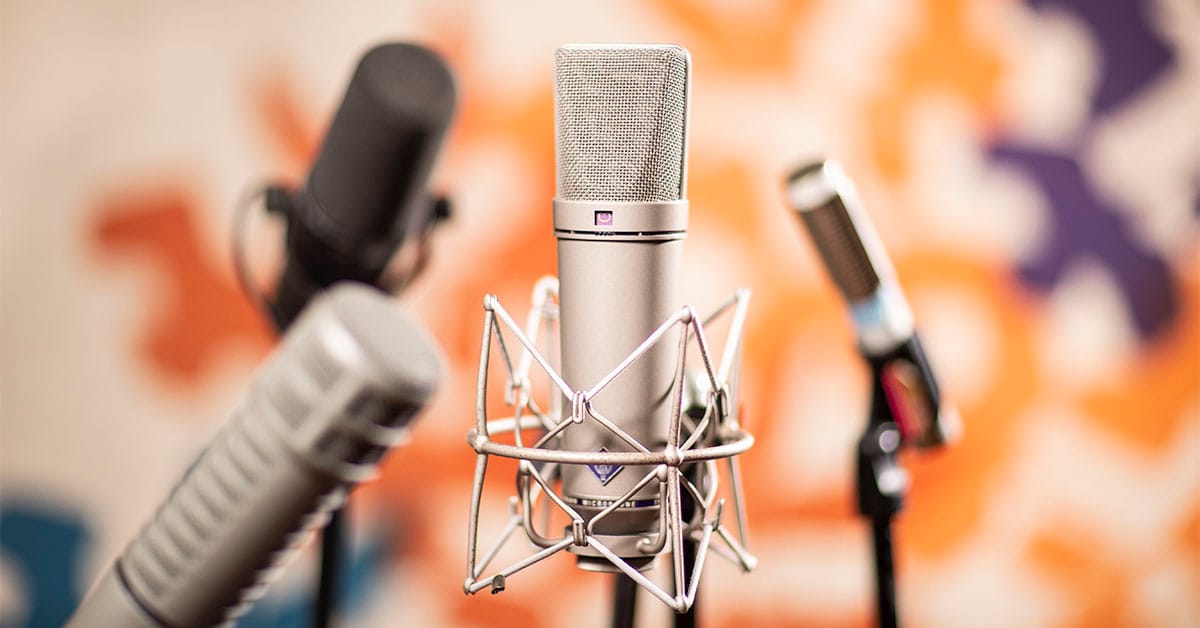With so many great microphones on the market, it can be difficult to know which ones are the best for your studio. From studio workhorse microphones to those with extra mojo, a good assortment of microphones will have you well prepared for any scenario and impress your clients, too. In this blog, we’ll share some of the most popular studio microphones to help you build a great mic locker without breaking the bank.
Whether you’re not sure where to begin or you already know what you need and just want help procuring gear that’s difficult to find, contact the experts at Guitar Center Professional for a free consultation.
Table of Contents
Condenser Microphones
Recommended Studio Condenser Microphones
Manley Reference Gold Mono
Neumann U 87 Ai
TELEFUNKEN TF47
Budget-friendly Studio Condenser Microphones
Sony C-100
Lauten Audio LA-320
Warm Audio WA-47
Dynamic Microphones
Recommended Studio Dynamic Microphones
Shure SM58
Shure SM57
Shure SM7B
Electro-Voice RE20
Heil Sound PR 40
Neumann BCM 705
Ribbon Microphones
Recommended Studio Ribbon Microphones
Royer R-121
Shure KSM353
sE Electronics Rupert Neve Active Ribbon
Budget-friendly Studio Ribbon Microphones
Royer R-10 Matched Pair
sE Electronics Voodoo VR1
AEA KU5A
Studio Microphone Wrap-Up
Condenser Microphones
Most condenser microphones are designed to operate by phantom power, a supply of 48V. They generally have the flattest, widest frequency response, and often include some additional user-selectable features, including pads and roll-off filters. Large-diaphragm condensers (LDCs), especially tube mics, tend to add more color to the sound while small-diaphragm condensers (SDCs) offer a more focused, neutral recording.
Condenser microphones often feature variable pickup patterns for versatility, like cardioid, figure-8 and omni. A cardioid pickup pattern is standard in many situations, like vocal recording and close mic placement for instruments. Omni can be used to capture a room’s ambiance, while figure-8 is quite versatile—it can be used to record two performers or as part of a stereo pair. Condenser microphones are commonly used for recording vocals and acoustic instruments, but also make great choices for room mics, drum overheads and a myriad of creative uses thanks to their sensitivity and full frequency response.
Recommended Studio Condenser Microphones
Manley Reference Gold Mono
Why It's Cool: A readily available, easily replaceable tube makes maintenance incredibly easy.
Things to Consider:
- Diaphragm film tensioned by hand
- 12AX7WA tube is easily replaceable
- Enhanced high-frequency response
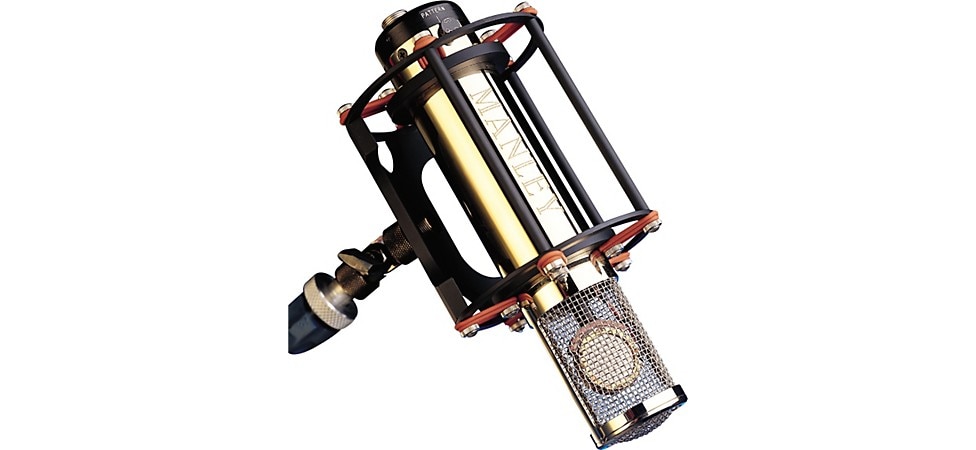
Pictured: Manley Reference Mono Gold Microphone
With its multi-pattern large-diaphragm CK12-style American-made capsule, wide frequency range and accurate transient response, the Manley Reference Gold tube microphone captures audio without any coloration. It’s been engineered to capture nuanced, musical recordings with a degree of accuracy that is truly unsurpassed.
Neumann U 87 Ai
Why It's Cool: The U 87 is such a studio standard that many singers and players demand it.
Things to Consider:
- Natural tone makes it great for virtually any source
- -10dB pad allows for SPL up to 127dB
- Can be a bit mid-forward for some singers
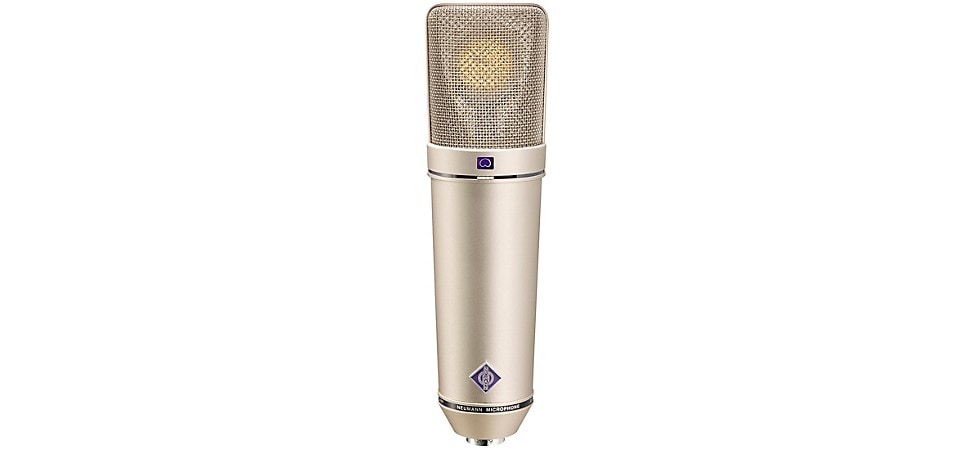
Pictured: Neumann U 87 Ai Large-Diaphragm Condenser Microphone
One of the most revered studio microphones of all time, the Neumann U 87 Ai is known to be the ultimate studio standard. It’s natural, balanced tone makes it a great choice on almost any source. It offers three pickup patterns—cardioid, omni and figure-8, which makes it a versatile choice that delivers predictable and consistent performance in any scenario.
TELEFUNKEN TF47
Why It's Cool: The TF47 builds on some of the most in-demand mics of all time to create a modern classic.
Things to Consider:
- Superb on vocals, guitar amps and drums—also low-frequency sources like bass or trombone
- Proper mic technique goes a long way for vocalists with this mic
- As with any tube mic, best to always have a spare tube for backup
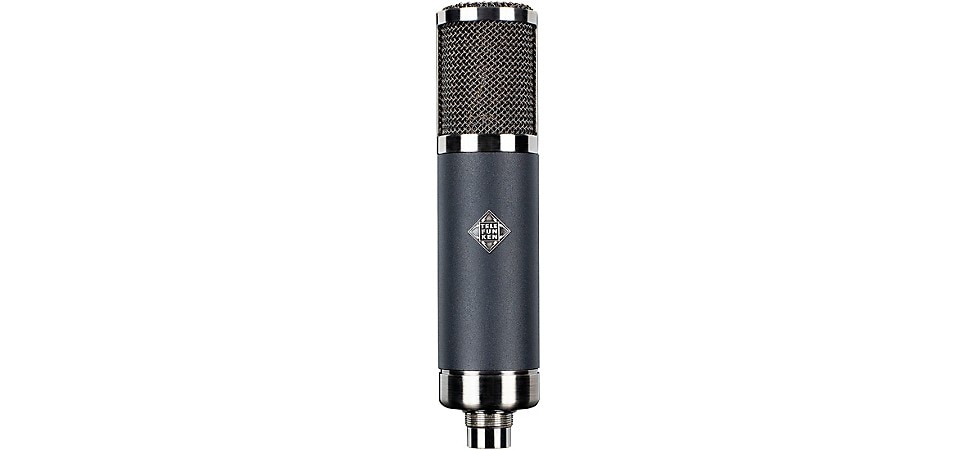
Pictured: Telefunken TF47 Tube Microphone
The TF47 is a modern tube microphone heavily inspired by some of the most legendary mics in history: the U47 and M49. With full, deep bass and smooth highs, the TF47 shines on any source that needs some extra presence. It’s assembled with a custom K47 capsule, TELEFUNKEN 5840W tube and a custom BV8 output transformer.
Budget-friendly Studio Condenser Microphones
Sony C-100
Why It's Cool: The expanded high-frequency response adds a huge amount of "air" to recordings.
Things to Consider:
- Unique dual-element capsule (regular condenser plus electret condenser) expands the highs
- Great for high-res (24-bit/96k and higher) captures
- Over 113dB dynamic range
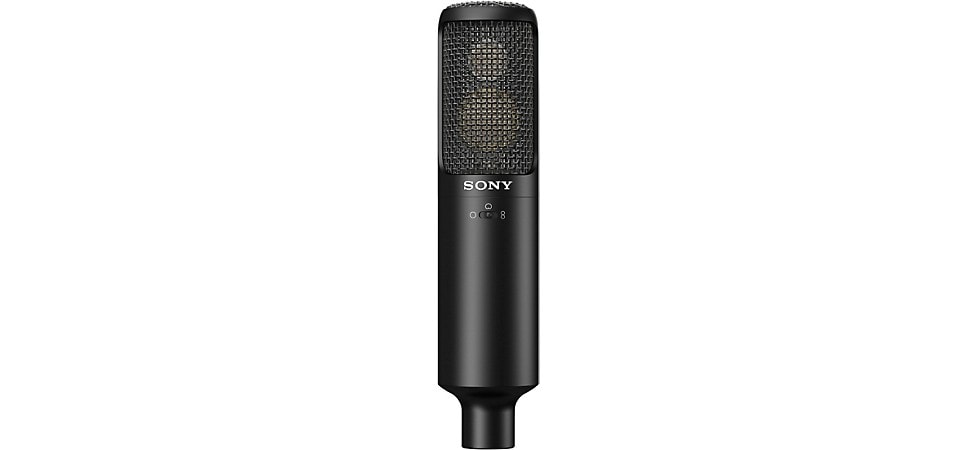
Pictured: Sony C-100 Studio Vocal Microphone
The Sony C-100 is a two-way condenser microphone with an extra-wide frequency range of 20Hz to 50,000Hz. The C-100 utilizes some of the same design concepts found in the revered C-800G, with excellent reproduction for vocals and acoustic sources. It has all the features you’d expect in a professional condenser mic, including switchable polar patterns, a low-cut filter and -10dB pad switch.
Lauten Audio LA-320
Why It's Cool: The ability to switch from vintage tube to modern tube in a single mic is unique
Things to Consider:
- Designed for high-end sound without needing a high-end vocal chain (though that never hurts)
- Ability to switch between circuits makes it effectively two mics in one
- Both high-pass and low-pass filters are switchable, and can act like additional tone control
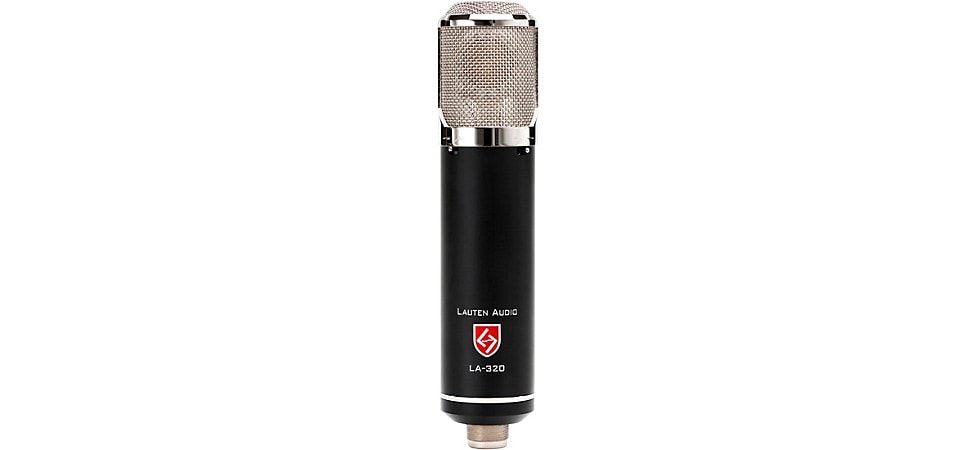
Pictured: Lauten Audio LA-320 Twin-Tone Tube Condenser Microphone
The LA-320 is a unique microphone with a twin-tone design that combines vintage tone with modern clarity. The signal path includes a dual-triode vacuum tube, USA-made JFET and a vintage-inspired output transformer that delivers a clear, balanced professional sound at an accessible price.
Warm Audio WA-47
Why It's Cool: Get classic tube mic sound for a fraction of the cost.
Things to Consider:
- Designed to emulate the sonic signature of the legendary U 47
- Great for vocals, guitars and brass
- Uses 7-pin cable to connect to power supply—have a spare, just in case
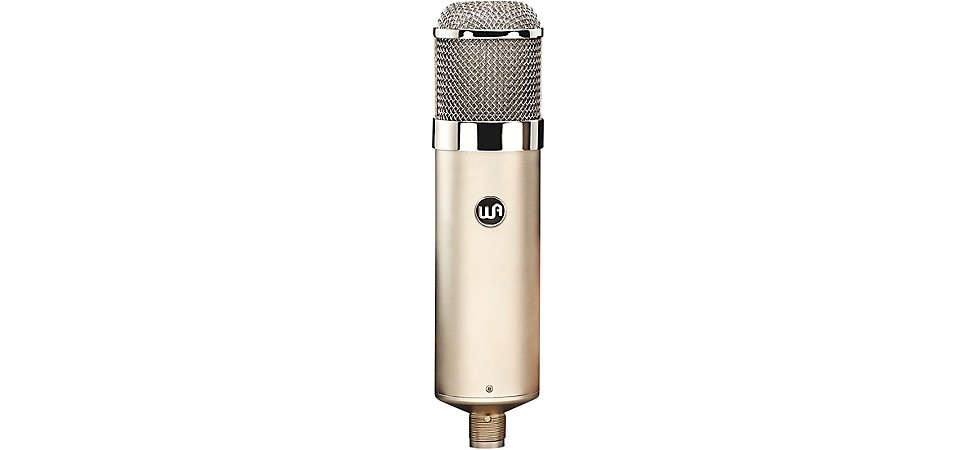
Pictured: Warm Audio WA-47 Tube Condenser Microphone
Inspired by the classic U47, the WA-47 is a vacuum tube, large diaphragm condenser microphone with tons of vibe. The original U47, which hasn’t been manufactured in decades, can be heard on countless recordings from the last half century. It has one of the most distinguishable mid-forward sounds, which is part of its appeal to so many engineers, artists and producers. With a sub-$1000 price tag, Warm Audio has made the sound of this legendary microphone more accessible than ever before.
Contact the experts at Guitar Center Professional for a free consultation and help with condenser microphones.
Dynamic Microphones
Dynamic microphones are great for capturing sound sources with high sound pressure levels. Their rugged and durable builds make them ideal for frequent use, both in the studio and in live settings. Most dynamic microphones utilize a focused cardioid pickup pattern, which helps reject unwanted sound and offers additional isolation benefits. Because of their durability and ability to handle high SPLs, dynamic mics are commonly used to close-mic drums and guitar cabs.
Dynamic microphones also tend to cost less than condenser microphones and come in both small- and large-diaphragm configurations, which makes them useful for many applications. For example, dynamic microphones are a great choice if you live in an apartment near a noisy street. Since they pick up less ambient noise, you may find that they capture more focused audio compared to a condenser microphone. Two classic microphones, the Shure SM7B and EV RE20, are popular home studio choices for this reason. Even the most famous, iconic recording studios in the world still use the Shure SM7B and EV RE20 when it’s the right choice for a particular audio source.
Recommended Studio Dynamic Microphones
Shure SM58
Why It's Cool: The classic handheld dynamic vocal mic, bar none.
Things to Consider:
- Incredibly versatile for both vocals and as instrument mic on high-SPL sources
- For singers who like to record as if they were performing
- Strong proximity effect, so proper mic technique is important to control "woofiness"
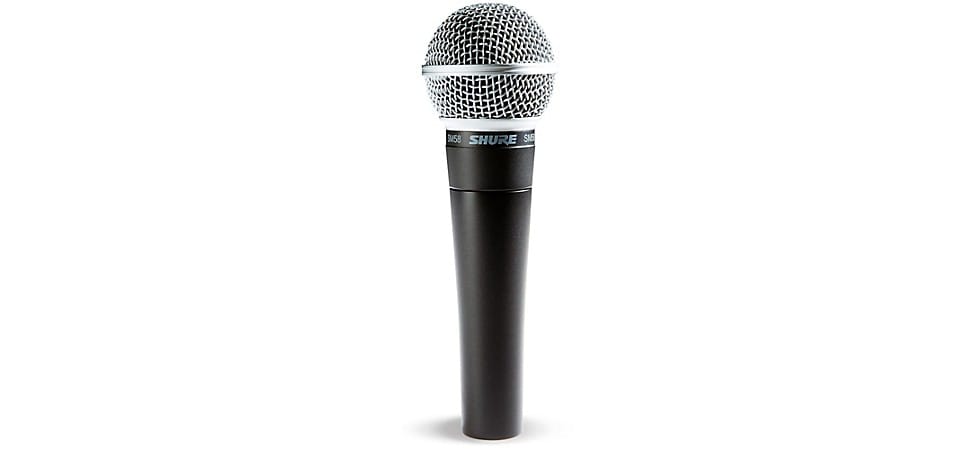
Pictured: Shure SM58 Dynamic Microphone
The Shure SM58 is an industry standard for vocals and speech. With an integrated pneumatic shockmount, windscreen and rugged design, the SM58 is one of the most popular studio mics for good reason. It’s affordable, sounds great and is built for the demands of being regularly used, dropped and knocked over, session after session.
Shure SM57
Why It's Cool: Like its 58 sibling, the 57 is an incredibly versatile and durable dynamic mic that can go almost anywhere.
Things to Consider:
- Incredible versatility (we know we already said that, but if you could only have one mic, this would be it)
- Great in combination with ribbon or condenser mics on guitar amps
- Susceptible to wind/breath noise, so windscreens can be an essential accessory
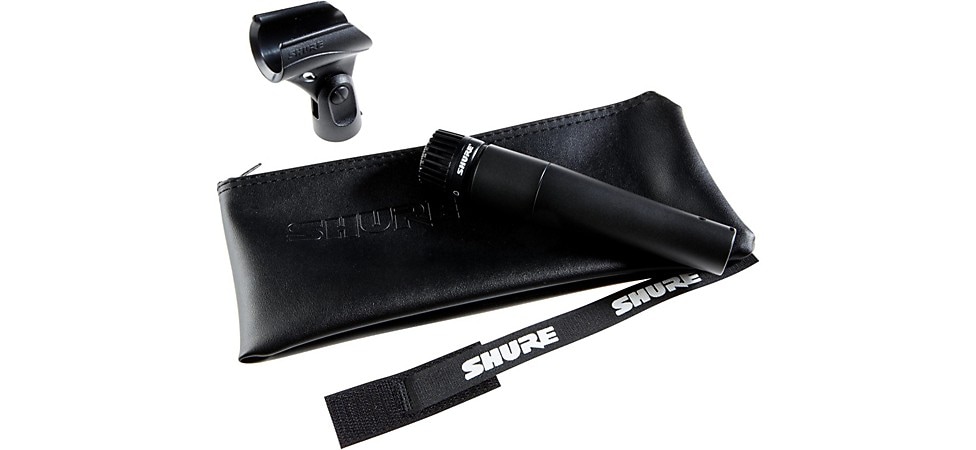
Pictured: Shure SM57 Dynamic Microphone
As a sibling to the SM58, the SM57 is a go-to mic for guitar amps, snare drums and more. Like the 58, the SM57 has an integrated pneumatic shockmount, can handle high SPL and is made to take abuse from the occasional errant drum stick.
Shure SM7B
Why It's Cool: In addition to being used on countless hit albums, it’s one of the best ways to get that classic radio announcer vibe.
Things to Consider:
- Learn to work the proximity effect on this to go from intimate whisper to full scream
- Great on vocals, guitar and bass amps
- Can require a little more gain than many other dynamic mics
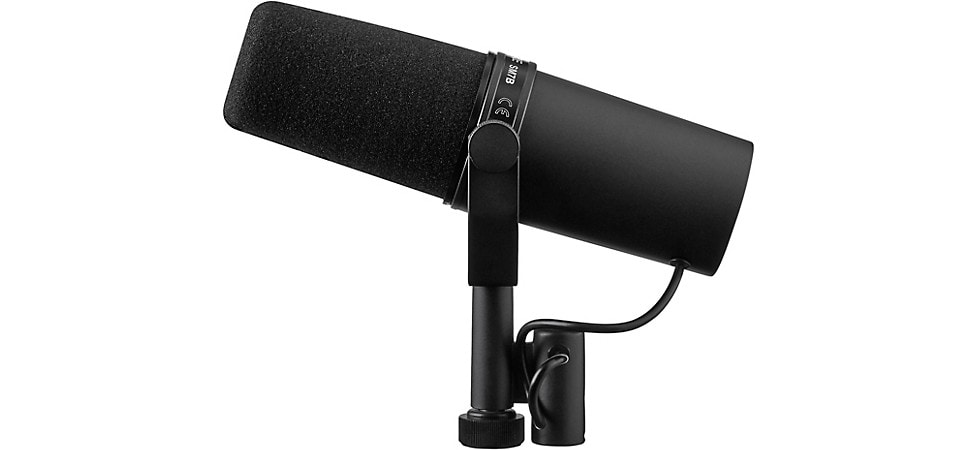
Pictured: Shure SM7B Cardioid Dynamic Microphone
The prolific SM7B can be found in almost any studio that records vocals. It's known for its signature warm and smooth tone, and includes a variety of features including a bass roll off, mid-range control and internal air suspension shockmount system. The cardioid pickup pattern does a great job at rejecting ambient noise, though the SM7B does require a bit more gain than other dynamic mics. Happily, you can get all of the sonic goodness of the SM7B along with a switchable gain boost in the Shure SM7dB. The SM7dB's built-in preamp offers a substantial 18db or 28dB of clean gain.
Electro-Voice RE20
Why It's Cool: The RE20's classic looks and big sound make it a versatile, go-to choice in a smaller studio—and a staple at major music and broadcast studios.
Things to Consider:
- Minimal proximity effect enables much closer working without getting boomy
- Superb kick drum and bass cabinet mic
- You may need to up your mic pre gain a little or use a mic booster
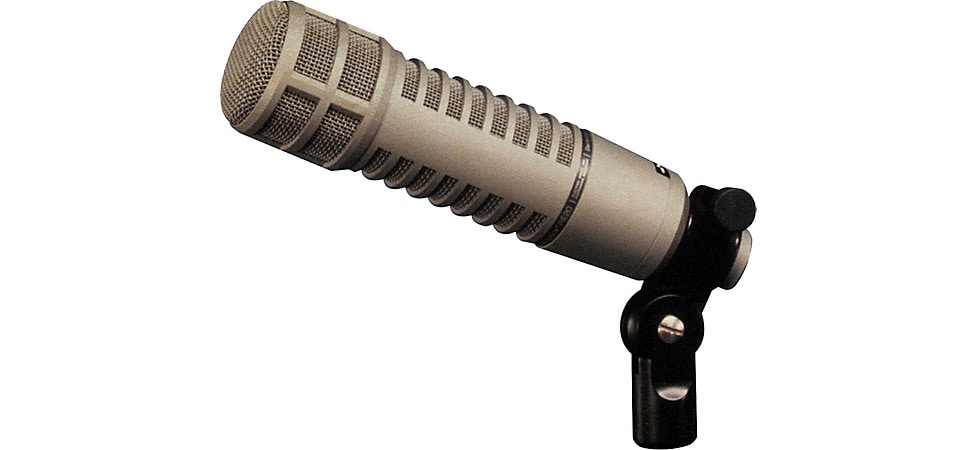
Pictured: Electro-Voice RE20 Dynamic Cardioid Microphone
The RE20 is not only one of the most popular broadcast announcer’s microphones of all time, it’s often used on kick drums, bass cabinets and more. It features a smooth, natural sound, Variable-D technology for minimal proximity effect and a humbucking coil design to guard against line hum. Like the SM7B, the EV RE20 will require some additional gain from your mic pre.
Heil Sound PR 40
Why It's Cool: Designed for versatility, the PR 40 can be your studio's "secret sauce."
Things to Consider:
- Another seriously flexible dynamic, at home in almost every application
- Tolerates very high SPL
- Despite its looks, it's an end-address mic, not side-address, so be mindful of placement
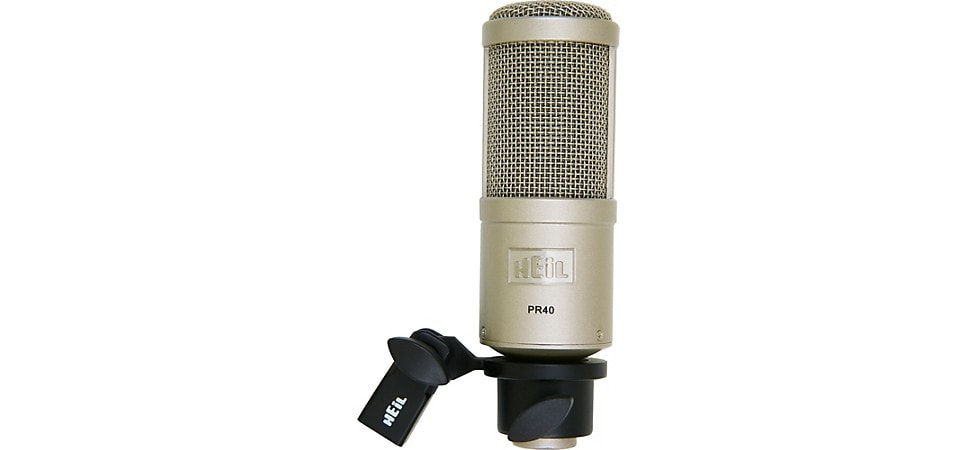
Pictured: Heil Sound PR 40 Large Diaphragm Multipurpose Dynamic Microphone
The PR 40 is the workhorse microphone of the Heil PR series. It offers the widest frequency response of any of the PR series mics, with a nearly flat response from 28Hz up to 18kHz. It’s a great choice for everything from vocals to bass drums and toms, to guitar and bass cabinets.
Neumann BCM 705
Why It's Cool: This hypercardioid dynamic mic is not just great for broadcast and voiceovers, but it's one of the coolest looking mics we know.
Things to Consider:
- Resistance to plosives and off-axis noise makes this an excellent mic for voiceover talent
- Removable grille is one of the easiest to clean that we’ve come across
- More specialized for the human voice and spoken word, so not as versatile as some other dynamics
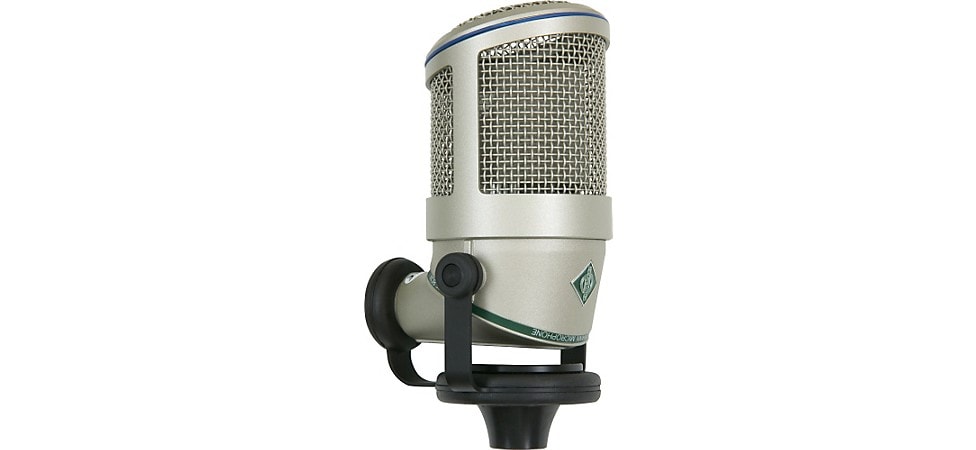
Pictured: Neumann BCM 705 Dynamic Studio Microphone
The Neumann BCM 705 features a hypercardioid pickup pattern, internal shockmount and pop filter to provide exceptional isolation from ambient noise and plosives. With a frequency response tailored for the human voice, it’s an ideal solution for broadcast facilities and small studios, including streaming and podcast applications.
Contact the experts at Guitar Center Professional for a free consultation to help you find the dynamic microphones that you need.
Ribbon Microphones
Ribbon microphones offer a classic warm, dark sound with rolled-off highs, though some newer active ribbon mics reproduce a more balanced sound. By design, ribbon microphones feature a figure-8 pickup pattern, which is ideal for spacious, ambient recordings. They’re capable of capturing very detailed recordings, making them a great choice for stringed instruments. Ribbon microphones often need more gain than condensers at the preamp, through either inline or dedicated external solutions, like the Royer dBooster and Cloudlifter CL-1.
Recommend Studio Ribbon Microphones
Royer R-121
Why It's Cool: The R-121 has become the epitome of the modern generation of ribbon mics.
Things to Consider:
- Ribbon mics "hear" sound very much like the human ear, delivering very natural sound with minimal EQ
- A pair of R-121s make great drum overheads when set up as a Blumlein pair
- Modern ribbons are far less delicate with more extended high-frequency response than vintage ones

Pictured: Royer R-121 Ribbon Microphone
The Royer R-121 features a figure-8 pickup pattern and sensitivity equal to a dynamic microphone. With a warm, natural tone and flare frequency response, the R-121 is more versatile than you might expect. It sounds great on a variety of sources and produces musical recordings. It’s also very sturdy and can even handle high SPL above 135dB. The R-121 is often paired with an SM57 on guitar amps and blended to taste.
Shure KSM353
Why It's Cool: The KSM353 combines Shure's traditional super-rugged construction with a uniquely durable proprietary ribbon material.
Things to Consider:
- Handles up to 146dB SPL so great for close-miked amp cabinets and kick drums
- Excellent as the figure-8 component of mid/side mic configurations
- High-frequency response cuts off at 15kHz, which can be great for mellowing out a bright source
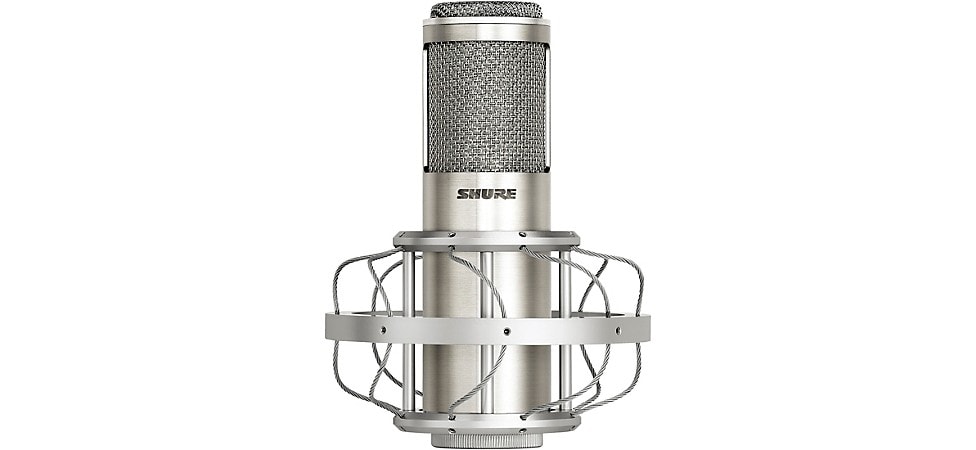
Pictured: Shure KSM353/ED Premier Bi-directional Ribbon Microphone
The KSM353 consists of a bidirectional figure-8 pickup pattern, with off-axis rejection. It features a durable build and custom transformer that stops RF interference in its tracks for cleaner recordings with improved noise performance. It can handle up to 146dB SPL from 30Hz to 15,000Hz, which makes it a great mic for vocals, acoustic instruments and concert halls.
sE Electronics Rupert Neve Active Ribbon
Why It's Cool: The combination of a Rupert Neve design and an active ribbon mic brings your sound to a whole new level.
Things to Consider:
- Extended high-frequency response is exceptionally smooth, for natural detail
- Easily handles up to 135dB SPL
- Superb for any source that needs both natural warmth and high-end detail
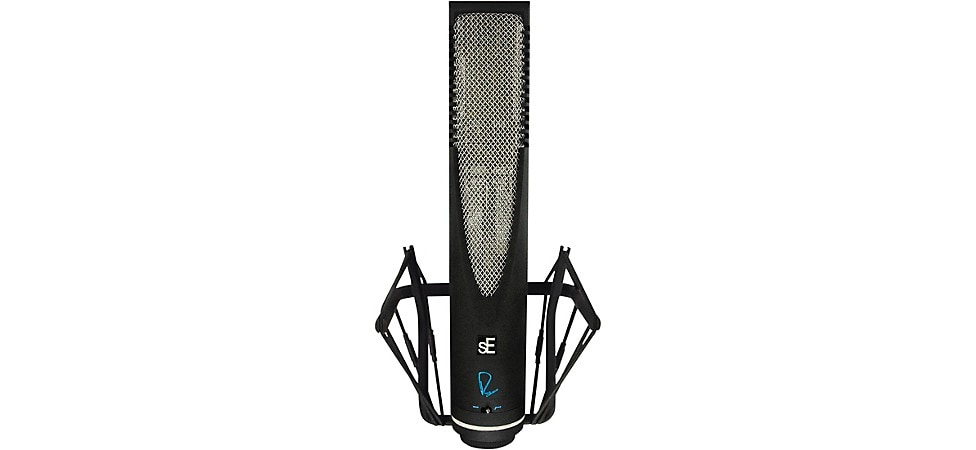
Pictured: SE Electronics Rupert Neve Active Ribbon Microphone
Designed and built in collaboration with pioneering audio gear designer Rupert Neve and sE Electronics, the RNR1 is a unique ribbon mic that helps brighten up your sources. With a frequency response of 20Hz to 25kHz, the RNR1 delivers the vibe of a ribbon microphone without sacrificing upper frequency response. It features a mild presence boost from 7kHz to 10kHz and a max SPL rating of more than 135dB.
Budget-friendly Studio Ribbon Microphones
Royer R-10 Matched Pair
Why It's Cool: If you're "ribbon-curious," the Royer R-10 is more than just a great introduction to the type, but an extremely versatile addition to your mic closet.
Things to Consider:
- Matched pair opens the doors to a new world of stereo applications, like XY or spaced drum overheads and Blumlein pairs
- Features three layers of windscreen protection and internal shockmount, for a seriously sturdy design
- Passive ribbons tend to need a little extra gain from a mic booster or preamp
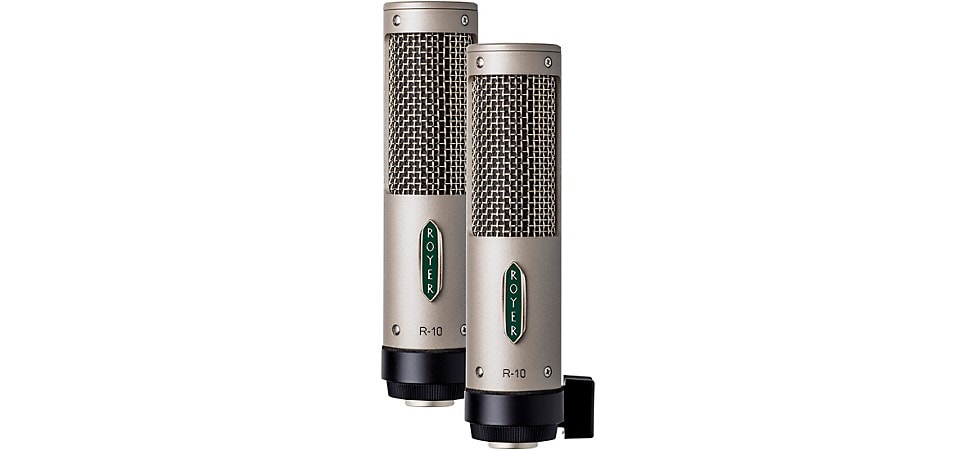
Pictured: Royer R-10 Ribbon Microphone Matched Pair
The Royer R-10 is a passive mono ribbon mic designed for studio and live performances. The ribbon transducer is protected by a three-layer windscreen and internal shockmount design. It’s an excellent choice for brass, drums, violins, acoustic guitars and more. It can handle exceptionally high SPL, with a max rating of 160dB.
sE Electronics Voodoo VR1
Why It's Cool: It's got the best extended high-frequency response in affordable passive ribbon mics.
Things to Consider:
- Response up to 18kHz for silky smooth, detailed highs
- Handles over 150dB SPL, so you get as loud as you want
- Once again, as a passive ribbon design, you'll need a little extra gain in the mic pre
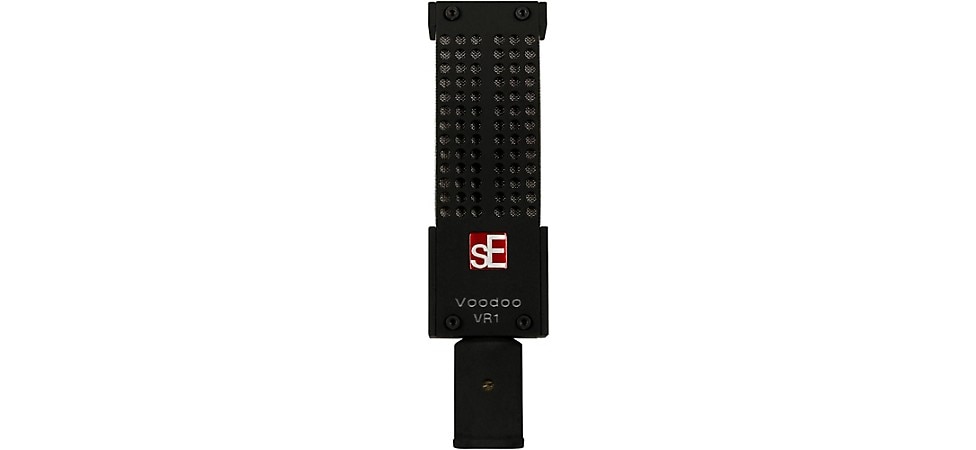
Pictured: sE Electronics Voodoo VR1 Ribbon Microphone
The VR1 from sE Electronics is an affordable passive ribbon microphone with a frequency response of 20Hz to 18kHz. Like other ribbon mics, it performs well on a variety of sources, but is best known for capturing great recordings of acoustic instruments and guitar cabinets.
AEA KU5A
Why It's Cool: With a super-tight polar pattern and a ribbon's natural warmth and detail, the KU5A is a stellar selection for vocals and more.
Things to Consider:
- Supercardioid pattern makes this a great mic for live recording or where physical isolation is a problem
- Seven layers of windscreen offer max protection for the ribbon—but still use a pop filter if you put this on a kick
- Switchable high-pass filter for excellent near-field performance
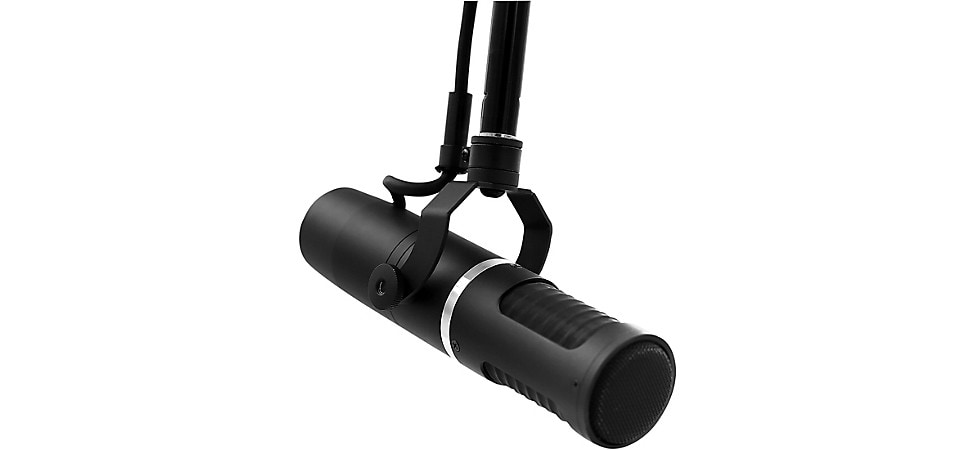
Pictured: AEA KU5A Supercardioid End-Address Ribbon Microphone
Sharing more than a little in common with the vintage RCA BK-5A, the AEA KU5A delivers a tight supercardioid pattern while keeping all the warmth and richness you expect from a ribbon. As a vocal mic, it delivers the full, intimate sound you want, with a switchable high-pass filter that tames the proximity effect for close work in higher-volume live environments. With the capacity to handle up to 135dB SPL, it's equally great for amps, drums and other sources where you desire that "ribbon vibe."
Studio Microphone Wrap-Up
When you build your mic locker, it’s important to have a variety of options at your disposal. From workhorse dynamic mics that get the job done reliably to tube mics for vintage vibe, there’s a use for every mic in your locker. Whether it’s a sturdy dynamic SM57 that can take the beating of a session drummer, or a TELEFUNKEN TF47 for extra vocal mojo, a well-stocked mic locker will set you up for success in any scenario.




